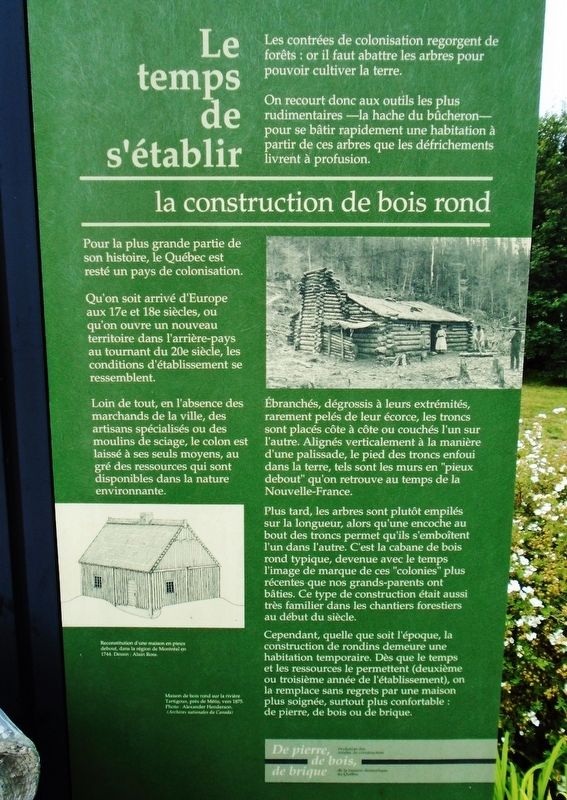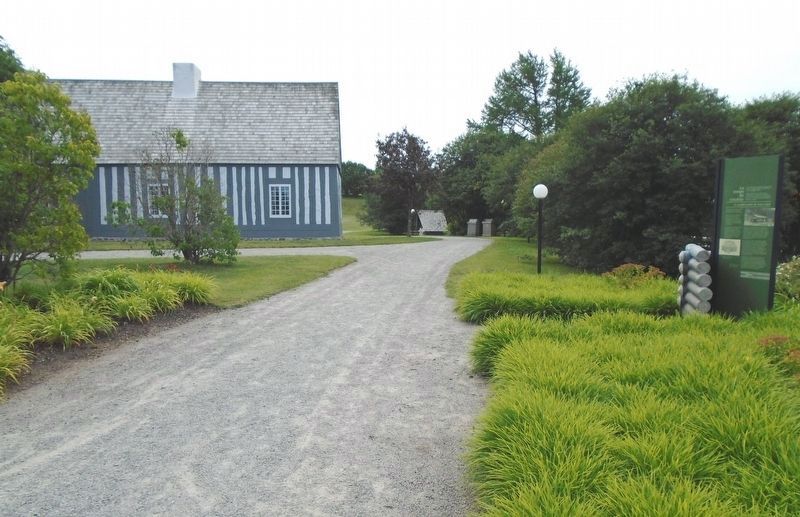Le temps de s'établir / Time to Settle
la construction de bois rond / round wood construction
— De pierre, de bois, de brique / Stone, Wood, Brick —
Les contrées de colonisation regorgent de forêts : or il faut abattre les arbres pour pouvoir cultiver la terre.
On recourt donc aux outils les plus rudimentaires —la hache du bûcheron— pour se bâtir rapidement une habitation à partir de ces arbres que les défrichements livrent à profusion.
Pour la plus grande partie de son histoire, le Québec est resté un pays de colonisation.
Qu'on soit arrivé d'Europe aux 17e et 18e siècles, ou qu'on ouvre un nouveau territoire dans l'arrière-pays au tournant du 20e siècle, les conditions d'établissement se ressemblent.
Loin de tout, en l'absence des marchands de la ville, des artisans spécialisés ou des moulins de sciage, le colon est laissé à ses seuls moyens, au gré des ressources qui sont disponibles dans la nature environnante.
Ébranchés, dégrossis à leurs extrémités, rarement pelés de leur écorce, les troncs sont placés côte à côte ou couchés l'un sur l'autre. Alignés verticalement à la mainière d'une palissade, le pied des troncs enfoui dans la terre, tels sont les murs en "pieux debout" qu'on retrouve au temps de la Nouvelle-France.
Plus tard, les abres
sont plutôt empilés sur la longueur, alors qu'une encoche au bout des troncs permet qu'ils s'emboîtent l'un dans l'autre. C'est la cabane de bois rond typique, devenue avec le temps l'image de marque de ces "colonies" plus récentes que nos grands-parents ont bâties. Ce type de construction était aussi très familier dans les chantiers forestiers au début du siècle.Cependant, quelle que soit l'époque, la construction de rondins demeure une habitation temporaire. Dès que le temps et les ressources le permettent (deuxième ou troisième année de l'établissement), on la remplace sans regrets par une maison plus soignée, surtout plus confortable : de pierre, de bois ou de brique.
[Légendes des illustrations lues]
Reconstitution d'une maison en pieux debout, dans la région de Montréal en 1744.
Maison de bois rond sur la rivière Tartigoux, près de Métis, vers 1875.
The colonized countries were full of forests: it was necessary to cut the trees to be able to cultivate the land.
Settlers therefore used the most rudimentary tool - the woodcutter's ax - to quickly build homes from the profusion of trees that were cleared.
For most of its history, Quebec remained a country of colonization.
Whether one arrived from Europe in the 17th and 18th centuries, or that a new territory was opened in the
Far from it all, in the absence of the city's merchants, specialized craftsmen or sawmills, the settler was left to his own means, dependent on the natural resources that were available in his surroundings.
Branched, trimmed at their extremities, bark rarely peeled, the trunks were placed side by side or lying one on top of the other. Aligned vertically at the hand of a palisade, the foot of the trunks buried in the ground, such were the "standing piles" walls then found in New France.
Later, however, the trees were stacked along their length, while a notch at the end of the trunks allowed them to fit one into another. This was the typical log cabin, which had become, over time, the image of the more recent "colonies" that our grandparents had built. This type of construction was also very familiar in the forests at the beginning of the century.
However, whatever the era, log construction remained only as a temporary dwelling. As soon as time and resources allowed (typically the second or third year of settlement), it was replaced without regrets with a house more neat and especially more comfortable: stone, wood or brick.
Topics. This historical marker is listed in these topic lists: Architecture • Horticulture & Forestry • Settlements & Settlers. A significant historical year for this entry is 1744.
Location.
Other nearby markers. At least 8 other markers are within walking distance of this marker. Façons de France ...en Amérique / French Ways ...in America (here, next to this marker); Pierre des champs... pierre des villes / Stones of the fields... stones of the cities (a few steps from this marker); Une forêt pour sa maison / A forest for his house (a few steps from this marker); Un jeu de blocs... d'argile / A set of blocks ... of clay (within shouting distance of this marker); Maison Lamontagne House (within shouting distance of this marker); Maisons d'aujourd'hui / Today's Houses (within shouting distance of this marker); La maison du commerce / The House of Commerce (within shouting distance of this marker); Maisons des faubourgs / Suburban Houses (within shouting distance of this marker). Touch for a list and map of all markers in Rimouski.
Regarding Le temps de s'établir / Time to Settle. Marker is one of a series highlighting the evolution of Quebec domestic architecture, titled, Stone, Wood, Brick.
Also see . . .
1. Maison Lamontagne House Historic Site. (Submitted on December 4, 2018, by William Fischer, Jr. of Scranton, Pennsylvania.)
2. The old architecture of Quebec (Traquair, 1947). (Submitted on December 4, 2018, by William Fischer, Jr. of Scranton, Pennsylvania.)
Credits. This page was last revised on January 20, 2020. It was originally submitted on December 4, 2018, by William Fischer, Jr. of Scranton, Pennsylvania. This page has been viewed 108 times since then and 7 times this year. Photos: 1, 2. submitted on December 4, 2018, by William Fischer, Jr. of Scranton, Pennsylvania.

